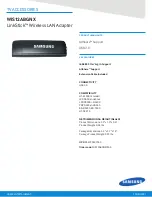
Jumper Pin Settings
Adjusting the jumper pins of a drive’s jumper block
designates the primary (master) or secondary (slave)
settings of the drive.
Figures 4-7
illustrate four of
the more common hard drive settings. Your drive
may differ from those pictured.
•
Master Drive –
The master drive (or in the case
of one drive) must always be installed on the end
of the Ultra ATA66 cable for proper termination.
Most drives are factory preset as a master drive.
Normally you do not need to reconfigure the
jumper pins of a master drive since it is already
preconfigured; however, if you are installing only
one drive, and its jumpers allow you to set it with
either a master or single setting (similar to the
setting illustrated for the Western Digital hard drive
in
Figure 7
), configure it as a single drive.
•
Slave Drive –
If a secondary drive is installed
onto the intermediate connector of an Ultra ATA66
cable, it is considered a slave drive and must be
properly configured by adjusting the jumper pins of
the drive’s jumper block.
2-3
Support Note:
Make sure to properly
configure the jumper pins of the hard
drive(s) for your system set-up, or your computer
may not boot.
40-pin IDE Connector
8-pin Jumper
Connector
4-pin Power
Connector
Manufacturer:
IBM
Model:
DJNA-352500
= Jumper On
= Jumper Off
Master
or Single
Slave
Figure 4
40-pin IDE Connector
8-pin Jumper
Connector
4-pin Power
Connector
Manufacturer:
Quantum
Model:
Fireball
™
lct
= Jumper On
= Jumper Off
Master/
Single
Slave
Figure 5
40-pin IDE Connector
8-pin Jumper
Connector
4-pin Power
Connector
Manufacturer:
Seagate
Model:
ST320423A
= Jumper On
= Jumper Off
Master/
Single
Slave
Figure 6
40-pin IDE Connector
10-pin Jumper
Connector
4-pin Power
Connector
Manufacturer:
Western Digital
Model:
WD Caviar
™
272AA
= Jumper On
= Jumper Off
Single
Master
Slave
Figure 7
















































